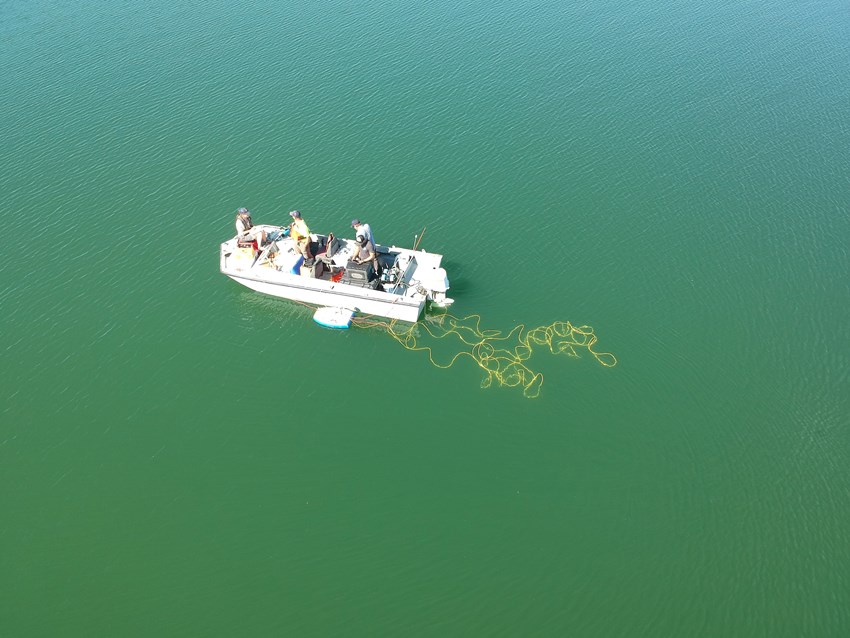UM Bio Station Researchers Call for Increased Collaboration and Technological Innovations in Global Fight against Invasive Species
Invasive species are a rising threat to biodiversity, national security, and regional economies. They travel by land, sea, and air—almost always with the unsuspecting aid of human activity—and the economic impacts cost billions of dollars each year in the United States alone. Guided by scientific knowledge, scientists and stakeholders have started to employ proactive and predictive approaches to stay one step ahead in the fight for invasive species prevention and mitigation.
Considering the speed of technological advancement and the rising need for cost-effective rapid response management plans, more guidance is needed to effectively use recent innovations on the ground. An international team of academic and government scientists, managers, and policy researchers, led by University of Montana Flathead Lake Biological Station (FLBS) postdoctoral researcher Charles van Rees and faculty Brian Hand and Gordon Luikart, set out to integrate cutting-edge technology into application-ready solutions for our 21st Century invasive species problem.
In a review recently published by the Cambridge Philosophical Society’s leading journal Biological Reviews, the team surveyed existing and emerging technologies and methodologies in a number of diverse scientific fields for their use on invasive species management and research. These technologies included remote sensing, environmental DNA sampling, big data analytics, genomics, epidemiology, trained detection dogs, and others. Throughout the review, the scientists highlighted any application or tool that had the potential to generate actionable science for the ongoing invasive species crises.
“The breadth and diversity of scientific and engineering disciplines whose technological advances feed into this study was staggering,” said van Rees. “We were incredibly fortunate to snowball together a team of experts with knowledge from many different fields to help put all of these exciting innovations into place in a coherent and practical action plan.”
During an assessment phase, the scientists found a variety of multidisciplinary tools and methods that could greatly aid in the fight against invasive species. These tools and methods include standardizing invasive species occurrence documentation, environmental information, and other data to increase sharing and usability between scientists and stakeholders; integrating semi-autonomous remote environmental sensors to increase opportunities for early detection; developing predictive computer modelling to better understand the likeliest potential pathways of spread; and creating universal language and terminology to increase lines of communication between scientists, decision-makers, and managers.
With this suite of tools in hand, the team created a conceptual framework about how to implement these tools and methods to help any stakeholder in any ecosystem seeking to mitigate or prevent the spread of any invasive species. So, whether working to prevent the arrival of invasive mussels in Montana or mitigating feral hogs in Florida, the proposed framework provides a pathway for scientists and stakeholders to contribute to a unified invasive prevention and mitigation effort in a coordinated, synergistic, and scalable manner.
“A key take-home from our work is that implementing this framework and carrying out these actions in a coordinated and effective way will take tremendous teamwork and communication,” said van Rees. “The next big steps in putting these efforts to work are designing tools and guidelines to help convene the sorts of interdisciplinary teams we need to make this a reality, and our team is already designing those sorts of tools in collaboration with researchers at the United States Geological Survey and NASA.”
The published review warned that, as the global extent and severity of biological invasions worsen and become more complex, many of the current reactive management and research plans and procedures will become untenable. Significant invasive species data—such as occurrences, population genetic data, and environmental information—must be collected, collated, and mobilized at large scales to promote appropriately rapid, coordinated, and accurately predicted responses to sustain and protect our native species and local ecosystems for future generations.
Additionally, van Rees hopes this review paper can help people from a lot of different backgrounds in science, technology, and policy understand how their work is relevant and where they can contribute.
“Collaboration is essential,” he said. “People have been saying this for decades, but we need to take concrete steps toward actually walking the walk now. The environmental challenges facing global society are too big to be solved piecemeal anymore, and the species invasion problem is a perfect example of that.”
In addition to van Rees, who is now based at the Odum School of Ecology and River Basin Center at the University of Georgia, additional FLBS authors on the review include FLBS assistant research professor Brian Hand, FLBS GIS/remote sensing research scientist Diane Whited, and FLBS conservation ecology and genetics professor Gordon Luikart.
For the complete paper, visit the Biological Reviews journal website at https://doi.org/10.1111/brv.12859
Sepulveda, A., N. Nelson, C. Jerde, and G. Luikart. 2020. Are environmental DNA methods ready for aquatic invasive species management? Trends in Ecology and Evolution, 35:668-678.
van Rees, C.B., B.K. Hand, C. Bargeron, T.J. Cline, W. Daniel, J.A. Ferrante, K. Gaddis, M.E. Hunter, C.S. Jarnevich, M.A. McGeoch, J. Morisette, M. Neilson, C. Rees, A. Sepulveda, R.D. Wallace, D. Whited, T. Wilcox, J. Kimball, and G. Luikart. 2022. Alien invasive species management needs methodological integration. Biological Reviews, in press.


